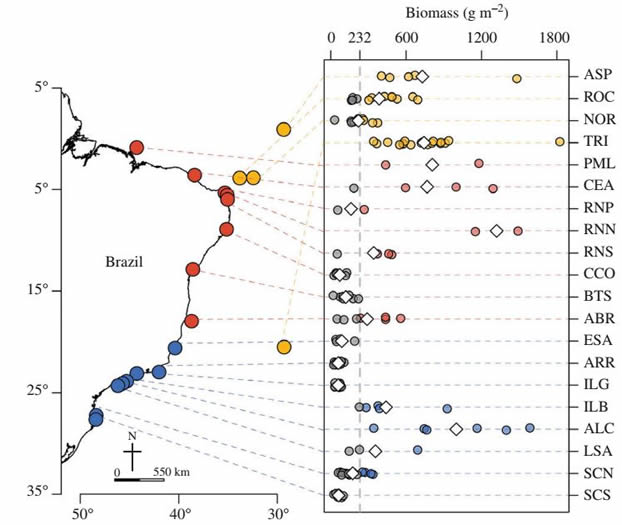|
Publications: Spatial patterns of fish standing biomass across Brazilian reefs
Scientist in Brazil have just taken a small step towards understanding where fish concentrate in shallow Brazilian
reefs and where they are most scarce. Over a period of more than 13 years, scientists have compiled an extensive
database of fish counts comprising more than 4,000 samples distributed in 137 sites and 20 localities along the
Brazilian coast and oceanic islands. Using this database, the authors were able to calculate how much biomass
exists in different reefs and, by comparing them, to tentatively suggest why they vary in so.
Results revealed that oceanic islands had more fish biomass than coastal reefs, either in tropical or subtropical
regions. However, sites with high fish biomass existed also along the coast, mainly in inaccessible or protected
localities.
Other interesting results concerned the so-called trophic groups of fishes. Whilst some fish groups (for example
large predators or large herbivores such as parrotfishes) follow a similar pattern to the overall biomass (being
higher in isolated or protected places), others behave very differently. Omnivorous fishes, for example, had higher
biomass in the oceanic islands and in subtropical reefs, being rare in tropical coastal reefs. Small herbivorous
fishes, on the contrary, were only abundant in some very shallow tropical locations. These shallow tropical places
host warm waters and receive high solar incidence that is ideal for the growth and photosynthesis of algae,their
food. In conjunction, the results suggest that fish biomass along Brazilian reefs might vary according to factors
such as water temperature, depth and isolation (or protection) from human impacts.
Portuguese version / versão em português
Cientistas brasileiros acabam de dar um pequeno passo na busca pelo conhecimento de onde peixes se
concentram e onde são mais escassos nos recifes rasos brasileiros. Nos últimos 13anos, pesquisadores
compilaram um grande volume de dados de contagens subaquáticas de peixes, com mais de 4000 amostras
distribuídas em 137 sítios e 20 localidades incluindo costa e ilhas oceânicas brasileiras. Com esses dados, os
autores foram capazes de estimar quanta biomassa existe nos diferentes recifes.
Os pesquisadores viram que ilhas oceânicas, em geral, tendem a ter maior biomassa do que recifes costeiros.
Locais com maior biomassa ocorreram também na costa, especialmente associados a áreas inacessíveis ou
protegidas.
Outros padrões interessantes foram observados quando os pesquisadores separaram os peixes em grupos
funcionais. Enquanto alguns grupos (grandes predadores ou grandes herbivoros, como bodiões-papagaios)
seguiram uma tendência similar à da biomassa como um todo, outros diferiram consideravelmente. Por exemplo,
peixes onívoros se concentraram nas ilhas oceânicas e recifes subtropicais, sendo raros nos tróficos. Pequenos
herbívoros, por outro lado, foram abundantes em localidades tropicais bastante rasas. Em conjunto, os resultados
do trabalho sugeriram que a quantidade de peixes nos recifes brasileiros provavelmente depende de fatores como
temperatura da água, profundidade e isolamento (ou proteção) de impactos humanos.

Reference: Morais RA, Ferreira CEL & Floeter SR. 2017. Spatial patterns of fish standing biomass across Brazilian
reefs, Southwestern Atlantic. Journal of Fish Biology, doi:10.1111/jfb.13482 PDF
Written by paper authors 10/2017
|










